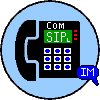 Com
SIP
L
Com
SIP
L
 Com
SIP
L Com
SIP
L
|
TM |
|
About SIPACD SIPACD is an optional ComSIPL server companant. SIPACD provides Automated Call Distrobution (ACD) for services like call centers or hunt groups. The SIPACD server may be installed on the same server environment run SIPL or as a seperate server with it's own IP. If you are running SIPACD as it's own server, you may run as many SIPACD servers as needed. Process The Caller places call and sends the SIP INVITE packet outbound. The SIP comes into SIPL server. The SIPL server reads the called directory number (DN), If the SIPL server determins it is a special trigger/pilot number, SIPL sends the INVITE to the SIPACD server. Uusually to port 5070 SIPACD recieves the SIP INVITE packet. SIPACD reads trigger/pilot called DN SIPACD looks at logic to determine which agent(s) DN(s) to then send the INVITE to. The SIP INVITE packet retains all the information contained from the SIPL server write.  Programming Hunt Groups or Call Centers To program a hunt group or callcenter directory number (DN, also known as pilots or triggers), the DN must be configured in the 'manual configuration' in SIPL. This is so that SIPL knows that this is not a standard SIP client when recieving an INVITE packet. The DN must point to the ACD server's IP, be assigned to the public partition, and given a device type. On the SIPL server, the DN for the SIPACD should be set as a CTI SIP server in the manual device configuration. If editing via a text editor: - If SIPACD is to run beside SIPL, the device type should be 002. - If SIPACD is to run as an additional server, device type should be 002 or 011 |